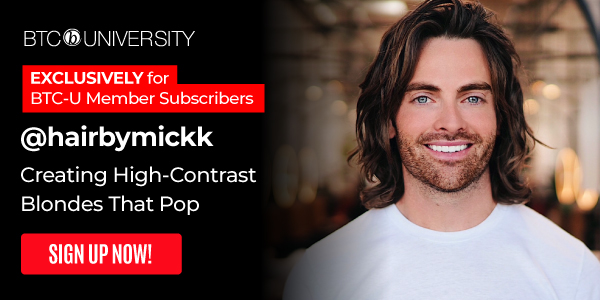Clients With Lice? Read This!
7 Myths About Lice You Should Know
Have you ever discovered lice behind your chair? If you’re like a lot of other stylists, you might not have known what to do. “It’s actually really sad how little hairdressers have been taught about lice,” says Monica Veley, CEO of Nitorious B.U.G. LLC and a stylist in Green Bay, Wis. “But we need to be the front line for our guests AND make sure we’re handling it properly in the salon.”
So, if you notice a client who might have the bug, don’t freak out! Here are seven common lice myths you and your clients should know about, and what to do if you discover lice in your salon.
Access UNLIMITED Cutting, Blonding & Styling Education With A BTC-U Member Subscription—Click Here To Get 50% OFF An Annual Membership!
Myth #1: Mayonnaise (or Coca-Cola/Listerine/kerosene/coconut oil and vinegar) can all help treat lice.
None of these methods kill 100 percent of the lice or nits (louse eggs). The only effective way to get rid of lice is to pick them out one by one with a metal head lice and nit comb (like the Nitorious B.U.G. Terminator Comb).
Myth #2: If one of your clients has lice, throw out all salon capes and combs, and spray the entire salon with Lysol or bleach.
“I’ve even heard of salons shutting down entirely when they have a client with lice!” says Monica. Definitely not necessary. Just wipe down your station with bleach, sanitize combs in Barbicide and wash capes according to state code regulations.
Myth #3: If your client has lice, they need to wash and disinfect everything they’ve touched at home.
Lice are primarily transferred via head-to-head contact, and they cannot live off the head for more than 24 hours. So there’s no need for clients to wash furniture or clothing, spray mattresses or throw away stuffed animals. Simply tell your clients to:
- Change their sheets
- Put stuffed animals in a corner or a closet overnight.
Myth #4: Tea tree oil is the best preventative method for lice.
Tea tree oil is not the most effective preventative, says Monica. Instead, recommend your clients spray their head and back of their neck with a peppermint oil-based product. Also, recommend longer-haired children keep their hair pulled back at school.
Myth #5: You cannot get lice if you have colored hair.
Lice don’t care if hair has been colored. As long as a louse can grab on to a hair strand, it can make its way to the head where its food supply (blood) is.
Myth #6: Lice like dirty hair.
Head lice actually prefer clean hair since it is easier for the female to attach her eggs.
Myth #7: There’s now a mutant breed of super lice that’s harder to kill.
In the ‘90s, lice showed a resistance to the chemicals used to kill them, so drug companies lowered the dosage, which resulted in the continued growth in resistance. Those same companies have now coined the catchy media term “super lice” and have created shampoos they claim are now going to kill the so-called strain. There is no new mutant bug, it just comes down to failed treatment.
What Else You Should Know
According to Monica, many stylists have trouble with lice misidentification (dandruff and oil buildup are commonly mistaken for lice), so here are the characteristics you should look for:
- They’re always tear-drop shaped.
- They always sit on one side of the hair strand.
- They are always uniform in shape and size (this means every particle in the hair will look pretty much the same, whereas with dandruff, the particles will be different shapes and sizes).
- They are not always milky white—they can range in color from almost clear to almost black.
- They must be pried off the hair strand—they don’t easily slide or pull off.
Do you think your client has lice? Here’s what to do.
- DON’T: make a scene. Having lice can be embarrassing and scary! Quietly and discreetly explain that you suspect they might have lice, and provide advice on what to do next.
- DO: recommend a treatment method. Tell them the best route is finding a treatment facility, then advise them to Google lice treatment facilities nearby. Not one close enough? Lice treatment can be done at home by picking out each louse and nit, but be sure to explain that it will be a time-consuming, meticulous process and that a special lice comb must be purchased.
- Remember: most state regulations say salons CANNOT treat lice.
Have more questions about lice? Visit nitorousbug.com, or email info@nitoriousbug.com for more info.








